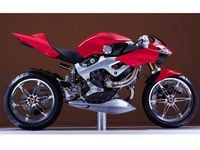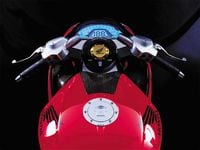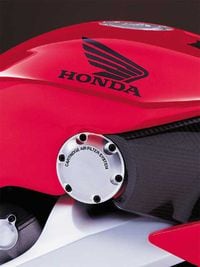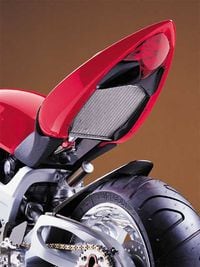The water is getting deeper in this little tidepool of transportation we call motorcycling and, in particular, a certain stretch of beach--the one inhabited by so-called naked bikes--is seeing the tide rise awfully fast. And yet Honda seems stuck on the beach, Tom Hanks-like, without a boat. Moreover, back in the world of sharp-penciled accountants, all is not ducky with Big Red; its VTR1000F has failed to capitalize on the V-twin boom and, if were to believe the pre-2002-launch buzz, there's no immediate replacement foraging for coconuts just beyond the tree line. These facts fuel our conjecture that the motorcycle you see here, which Honda calls the "New American Sports" (NAS, shown to all at Laguna Seca in July), might be both Honda's next VTR and its slightly off-the-beaten-path approach to building a new-age naked bike that isn't retro (like the Kawasaki ZRX), isn't based on a halo bike (like the FZ1) and isn't built to be the bargain leader (like the Bandit).
Of course, we could be totally wrong, because nothing in Honda's press information so much as hints at future production. Honda Research Americas' (HRA) executive designer, Martin Manchester, suggests that the NAS exists to shine a pencil beam into the murky future, but also to show off just how nicely the company can prepare and present what is ostensibly a little chunk of motofantasy. "This concept bike takes a new direction in motorcycling," Manchester says, "a path that emphasizes the beauty and aesthetics in the execution and creation of a sportbike." Hey, we're not done with the old direction.
Begun late in '99, the NAS was intended to be, we're told, a project that no one expected to see in production in the near future, so many of the usual constraints--the most oppressive of which was time--were removed or relaxed. HRA senior designer, Tony Schroeder, explains, "With an advanced project like the New American Sports, we aren't forced to work under a cloud of urgency; we're free to take our time and think outside of established norms and push the limits. Unlike most advanced projects, however, our goal with the NAS was to not only create the image of a futuristic machine, but we also had the green light to take the bike to an unusually high degree of finish work. Part of our goal was to develop and perfect new methods of model construction, and to push motorcycle engineering concepts into the 'What if?' realm."
Schroeder continues. We'll translate. "If you look at [today's] existing machines, you see that the top-tier sportbikes were designed by engineers for racing purposes; replica-racers own the spotlight." Meaning: You've seen it all before. "We wanted to set a new direction for sportbikes, but back to the street rather than toward the racetrack. The market for racer-style bikes is obviously strong, but we envisioned a different group of riders searching for a new category of sport machine." Translation: Somebody at the mothership heard all you guys with bad backs and creaky knees, and something more humane is in the works. (This is maybe a stretch, we think, because even the CBR929RR is pretty easy to live with.) "The vast majority of consumers spend their entire riding lives on the street, not the track, so it's not necessary to establish racing function as the top priority for these riders."
The subtext: We know there's a bunch of you who don't think that a CBR- anything winning at Daytona or Willow Springs is important and you're grown up enough to rent someone else's bike when you do go to the track. Y'all want streetbikes! "And so, we gave the New American Sports a highly personal, owner-directed allure by incorporating a superior level of execution, using visible mechanical parts that are highly stylized and finely finished." Like we said: naked. Sheesh, is this so hard, guys?
Manchester goes on to explain, "Performance always takes a high profile in motorcycling, but we were looking to reinforce the emotional attachment that owners have with their bikes. We achieved that goal by placing a major emphasis on the exposed hardware, dressing it up rather than concealing it behind bodywork. We've applied a great deal of forward-looking technology plus distinctive styling touches throughout, and lavished a huge amount of detail work on this bike. Because every bit of hardware on this machine has been designed for aesthetic appeal, the New American Sports purposely transcends the constraints typically dictated by production, function and cost issues."
Let's just look at that hardware, then. For the engine, we see elements of the RC51 in the "liter-class" V-twin, chosen, we're told, because it is an attractive engine with a "booming exhaust note." (But not when the EPA is done with it.) Also, says the team, "With such a large engine, a decision was made to center the bike's mass around the engine compartment, thereby leaving a light, open and airy appearance to the front and rear sections."
As you can see, the NAS embraces a number of untried technologies and packaging concepts. That monolithic front suspension is one, of course, but we won't be letting our faces turn blue waiting for that tidbit to make production. (Can you imagine the loads imposed on the bearing surfaces when you concentrate the parts like this?) Or how about that under- seat radiator fed, we're told, by one of the two snorkel inlets in the nose? Our curiosity is piqued by the eccentric adjusters on the front axle that allow the rider to change the bike's trail. Finally, you have that clever rim-mounted front brake--a la the new Buell Firebolt--that promises scads of leverage on that contact patch but may be vulnerable to damage.
Honda's given us plenty to consider in the NAS, of course, and our curmudgeonly assessments of the pen-to-production likelihood of the bike's technological leaps notwithstanding, we think it's a lovely piece of work. Look for something a bit like this bike to arrive in the not- too-distant future--probably wearing a conventional fork and brakes, without that underslung pod exhaust system and, probably, adorned with a traditionally mounted radiator--as Honda's bid to do something completely different in the burgeoning naked class. Surf's up.
















/cloudfront-us-east-1.images.arcpublishing.com/octane/S35YGSEMEZB4BLTDJTSZPF4GLA.jpg)
/cloudfront-us-east-1.images.arcpublishing.com/octane/5UOT6HPX2JFMRJAX6EH45AR4MQ.jpg)
/cloudfront-us-east-1.images.arcpublishing.com/octane/OKWOJWAKP5EP3OACCRRWPCIX2Q.jpg)
/cloudfront-us-east-1.images.arcpublishing.com/octane/2WF3SCE3NFBQXLDNJM7KMXA45E.jpg)
/cloudfront-us-east-1.images.arcpublishing.com/octane/G4MG6OUCJNBSHIS2MVVOTPX65E.jpg)
/cloudfront-us-east-1.images.arcpublishing.com/octane/IIGGWFOTOJGB7DB6DGBXCCMTDY.jpg)
/cloudfront-us-east-1.images.arcpublishing.com/octane/QSTCM6AVEZA5JJBUXNIQ3DSOF4.jpg)
/cloudfront-us-east-1.images.arcpublishing.com/octane/U4I7G625B5DMLF2DVIJDFZVV6M.jpg)
/cloudfront-us-east-1.images.arcpublishing.com/octane/B6XD6LS6IVCQPIU6HXDJSM3FHY.jpg)
/cloudfront-us-east-1.images.arcpublishing.com/octane/ICL63FEDDRDTTMINYICCEYGMDA.jpg)
/cloudfront-us-east-1.images.arcpublishing.com/octane/FCGZHQXRBZFLBAPC5SDIQLVF4I.jpg)
/cloudfront-us-east-1.images.arcpublishing.com/octane/WNOB6LDOIFFHJKPSVIWDYUGOPM.jpg)

/cloudfront-us-east-1.images.arcpublishing.com/octane/X33NU3E525ECRHXLNUJN2FTRKI.jpg)
/cloudfront-us-east-1.images.arcpublishing.com/octane/6KKT5NNL2JAVBOXMZYS5ZO76YA.jpg)
/cloudfront-us-east-1.images.arcpublishing.com/octane/J5RKG5O455GMPGQRF2OG6LRT7A.jpg)
/cloudfront-us-east-1.images.arcpublishing.com/octane/GX2CIZKQVRH2TATDM26KFG2DAE.jpg)
/cloudfront-us-east-1.images.arcpublishing.com/octane/ZWIDYSAKQZHD5BHREMQILXJCGM.jpg)
/cloudfront-us-east-1.images.arcpublishing.com/octane/CYUHJZCTSJCH3MRAQEIKXK7SCQ.jpg)
/cloudfront-us-east-1.images.arcpublishing.com/octane/LKOFINY56FCXJCANJ5M7ZDQUBY.jpg)
/cloudfront-us-east-1.images.arcpublishing.com/octane/4NBPDACMWJH63JQYJVK3QRBDZI.jpg)
/cloudfront-us-east-1.images.arcpublishing.com/octane/KKHQHRR3FJGX7H2IPU6RALMWG4.jpg)

/cloudfront-us-east-1.images.arcpublishing.com/octane/5IOFS5JAE5FOXMNA23ZRAVVYUU.jpg)